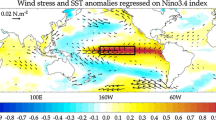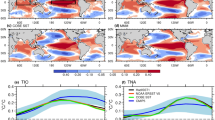Abstract
Remote forcing from El Niño-Southern oscillation (ENSO) and local ocean–atmosphere feedback are important for climate variability over the North Tropical Atlantic. These two factors are extracted by the ensemble mean and inter-member difference of a ten-member Pacific Ocean-Global Atmosphere (POGA) experiment, in which sea surface temperatures (SSTs) are restored to the observed anomalies over the tropical Pacific but fully coupled to the atmosphere elsewhere. POGA reasonably captures main features of the observed North Tropical Atlantic variability. Both ENSO forced and local North Tropical Atlantic Modes (NTAMs) develop with wind-evaporation-SST feedback. Notable biases exist. The seasonality of the simulated NTAM is delayed by 1 month, due to the late development of the North Atlantic Oscillation (NAO) in the model. This suggests the importance of NAO in setting the seasonality of NTAM and of the extratropical-tropical teleconnection. The simulated NTAM is closely related to the Atlantic Niño in the subsequent summer, a relationship not so obvious in observations. Local variability, represented by the preseason NAO and SST persistence, contributes considerably to NTAM variability. Including these two indicators, together with ENSO, improves the predictability of NTAM. The South Tropical Atlantic Mode can be forced by ENSO, and a cross-equatorial dipole is triggered by ENSO instead of local air-sea coupling within the tropical Atlantic.












Similar content being viewed by others
References
Adler RF, Huffman GJ, Chang A, Ferraro R, Xie P-P, Janowiak J, Rudolf B, Schneider U, Curtis S, Bolvin D, Gruber A, Susskind J, Arkin P, Nelkin E (2003) The Version-2 Global Precipitation Climatology Project (GPCP) monthly precipitation analysis (1979-present). J Hydrometeorol 4:1147–1167
Amaya DJ, Foltz GR (2014) Impacts of canonical and Modoki El Niño on tropical Atlantic SST. J Geophys Res Oceans 119:777–789
Amaya DJ, DeFlorio MJ, Miller AJ, Xie S-P (2016) WES feedback and the Atlantic Meridional Mode: observations and CMIP5 comparisons. Clim Dyn. doi:10.1007/s00382-016-3411-1
Bjerknes J (1969) Atmospheric teleconnections from the equatorial Pacific. Mon Weather Rev 97:163–172
Chang P, Ji L, Li H (1997) A decadal climate variation in the tropical Atlantic Ocean from thermodynamic air–sea interactions. Nature 385:516–518
Chang P, Ji L, Saravanan R (2001) A hybrid coupled model study of the tropical Atlantic variability. J Clim 14:361–390
Chang P, Fang Y, Saravanan R, Ji L, Seidel H (2006) The cause of the fragile relationship between the Pacific El Niño and the Atlantic Niño. Nat Biotechnol 443(7109):324 
Chiang JCH, Vimont D (2004) Analogous meridional modes of atmosphere–ocean variability in the tropical Pacific and tropical Atlantic. J Clim 17:4143–4158
Chiang JCH, Kushnir Y, Giannini A (2002) Deconstructing Atlantic Intertropical Convergence Zone variability: influence of the local cross-equatorial sea surface temperature gradient, and remote forcing from the eastern equatorial Pacific. J Geophys Res 107:4004. doi:10.1029/2000JD000307
Chikamoto Y, Timmermann A, Luo J-J, Mochizuki T, Kimoto M, Watanabe M, Ishii M, Xie S-P, Jin F-F (2015) Skilful multi-year predictions of tropical trans-basin climate variability. Nat Commun 6:6869
Covey DL, Hastenrath S (1978) The Pacific El Nino phenomenon and the Atlantic circulation. Mon Weather Rev 106:1280–1287
Czaja A, van der Vaart P, Marshall J (2002) A diagnostic study of the role of remote forcing in tropical Atlantic variability. J Clim 15:3280–3290
Dee DP et al (2011) The ERA-Interim reanalysis: configuration and performance of the data assimilation system. Q J R Meteorol Soc 137:553–597
Delecluse P, Servain J, Levy C, Arpe K, Bengtsson L (1994) On the connection between the 1984 Atlantic warm event and the 1982–1983 ENSO. Tellus 46A:448–464
Delworth TL, Mann ME (2000) Observed and simulated multidecadal variability in the Northern Hemisphere. Climate Dyn 16:661–676
Delworth TL et al (2006) GFDL’s CM2 global coupled climate models. Part I: formulation and simulation characteristics. J Clim 19:643–674
Doi T, Tozuka T, Yamagata T (2010) The Atlantic meridional mode and its coupled variabilitywith the GuineaDome. J Clim 23:455–475
Dommenget D, Latif M (2000) Interannual to decadal variability in the tropical Atlantic. J Clim 13:777–792
Enfield DB, Mayer DA (1997) Tropical Atlantic SST variability and its relation to El Niño–Southern Oscillation. J Geophys Res 102:929–945
Enfield DB, Mestas-Nun˜ez AM, Mayer DA, Cid-Serrano L (1999) How ubiquitous is the dipole relationship in tropical Atlantic sea surface temperature? J Geophys Res 104:7841–7848
Foltz GR, McPhaden MJ, Lumpkin R (2012) A strong Atlantic Meridional Mode event in 2009: the role of mixed layer dynamics. J Clim 25(1):363–380. doi:10.1175/Jcli-D-11-00150.1
GFDL Global Atmospheric Model Development Team (2004) The new GFDL global atmosphere and land model AM2–LM2: evaluation with prescribed SST simulations. J Clim 17:4641–4673. doi:10.1175/JCLI-3223.1
Giannini A, Kushnir Y, Cane MA (2000) Interannual variability of Caribbean rainfall, ENSO, and Atlantic Ocean. J Clim 13:297–311
Ham YG, Kug JS, Park JY, Jin FF (2013) Sea surface temperature in the North Tropical Atlantic as a trigger for El Niño/Southern Oscillation events. Nat Geosci 6:112–116
Hastenrath S (1984) Interannual variability and annual cycle: mechanisms of circulation and climate in the tropical Atlantic sector. Mon Weather Rev 112:1097–1107
Hastenrath S (2012) Exploring the climate problems of Brazil’s Nordeste: a review. Clim Change 112:243–251
Hastenrath S, Heller L (1977) Dynamics of climatic hazards in northeast Brazil. Q J R Meteorol Soc 103:77–92
Houghton RW, Tourre YM (1992) Characteristic low-frequency sea surface temperature fluctuations in the tropical Atlantic. J Clim 5:765–771
Hu ZZ, Huang BH (2006) Physical processes associated with the tropical Atlantic SST meridional gradient. J Clim 19:5500–5518
Huang B (2004) Remotely forced variability in the tropical Atlantic Ocean. Clim Dyn. doi:10.1007/s00382-004-0443-8
Huang BH, Shukla J (2005) Ocean-atmosphere interactions in the tropical and subtropical Atlantic Ocean. J Clim 18:1652–1672
Huang B, Schopf PS, Shukla J (2004) Intrinsic ocean–atmosphere variability of the tropical Atlantic Ocean. J Clim 17:2058–2077
Klein SA, Soden BJ, Lau N-C (1999) Remote sea surface variations during ENSO: evidence for a tropical atmospheric bridge. J Clim 12:917–932
Kosaka Y, Xie S-P. (2013) Recent global-warming hiatus tied to equatorial Pacific surface cooling. Nature 501:403–407
Kosaka Y, Xie S-P, Lau N-C, Vecchi GA (2013) Origin of seasonal predictability for summer climate over the northwestern Pacific. Proc Natl Acad Sci USA 110:7574–7579
Kushnir Y, Seager T, Miller J, Chiang JCH (2002) A simple coupled model of tropical Atlantic decadal climate variability. Geophys Res Lett 29:2133. doi:10.1029/2002GL015874
Lau N-C, Nath MJ (2000) Impact of ENSO on the variability of the Asian–Australian monsoons as simulated in GCM experiments. J Clim 13:4287–4309
Lau N-C, Nath MJ (2003) Atmosphere–ocean variations in the Indo-Pacific sector during ENSO episodes. J Clim 16:3–20
Li X, Xie S-P, Gille ST, Yoo C (2016) Atlantic-induced pan-tropical climate change over the past three decades. Nat Clim Change 6:275–279
Mahajan S, Saravanan R, Chang P (2010) Free and forced variability of the tropical Atlantic Ocean: role of the wind-evaporation-sea surface temperature feedback. J Clim 23:5958–5977
McGregor S, Timmermann A, Stuecker MF, England MH, Merrifield M, Jin FF, Chikamoto Y (2014) Recent Walker circulation strengthening and Pacific cooling amplified by Atlantic warming. Nat Clim Change 4:888–892
Mehta VM, Delworth T (1995) Decadal variability of the tropical Atlantic Ocean surface temperature in shipboard measurements and in a global ocean–atmosphere model. J Clim 8:172–190
Nnamchi H, Li J, Kucharski F, Kang I, Keenlyside NS, Chang P, Farneti R (2015) Thermodynamic controls of the Atlantic Niño. Nat Commun 6:8895. doi:10.1038/ncomms9895
Nobre P, Shukla J (1996) Variations of sea surface temperature, wind stress, and rainfall over the tropical Atlantic and South America. J Clim 9:2464–2479
Rayner NA, Parker DE, Horton EB, Folland CK, Alexander LV, Rowell DP, Kent EC, Kaplan A (2003) Global analyses of sea surface temperature, sea ice, and night marine air temperature since the late nineteenth century. J Geophys Res 108:4407
Richter I, Xie S-P (2008) On the origin of equatorial Atlantic biases in coupled general circulation models. Clim Dyn 31:587–598
Richter I, Xie S-P, Behera SK, Doi T, Masumoto Y (2014) Equatorial Atlantic variability and its relation to mean state biases in CMIP5. Clim Dyn 42:171–188.
Servain J (1991) Some simple climatic indices for the tropical Atlantic Ocean and some application. J Geophys Res 96:15137–15146
Smith TM, Reynolds RW, Peterson TC, Lawrimore J (2008) Improvements NOAAs historical merged land–ocean temp analysis (1880–2006). J Clim 21:2283–2296
Stockdale TN, Balmaseda MA, Vidard A (2006) Tropical Atlantic SST prediction with coupled ocean–atmosphere GCMs. J Clim 19:6047–6061
Sutton RT, Jewson SP, Rowell DP (2000) The elements of climate variability in the tropical Atlantic region. J Clim 13:3261–3284
Vimont DJ (2012) Analysis of the Atlantic meridional mode using linear inverse modeling: seasonality and regional influences. J Clim 25:1194–1212
Vimont DJ, Kossin JP (2007) The Atlantic meridional mode and hurricane activity. Geophys Res Lett 34:L07709. doi:10.1029/2007GL029683
Wang B, An S-I (2005) A method for detecting season-dependent modes of climate variability: S-EOF analysis. Geophys Res Lett 32:L15710
Wu L, Liu Z (2002) Searching for the role of ENSO in the tropical Atlantic variability. CLIVAR Exchanges 25(7):20–24
Wu L, Zhang Q, Liu Z (2004) Toward understanding tropical Atlantic variability using coupled modeling surgery. In: Earth climate: the ocean–atmosphere interaction. Geophysical monograph series, vol 147. American Geophysical Union, pp 157–170
Wu L, He F, Liu Z, Li C (2007) Atmospheric teleconnections of tropical Atlantic variability: interhemispheric, tropical–extratropical, and cross-basin interactions. J Clim 20:856–870
Xie S-P (1999) A dynamic ocean–atmosphere model of the tropical Atlantic decadal variability. J Clim 12:64–70
Xie S-P, Carton J (2004) Tropical Atlantic variability: patterns, mechanisms, and Impacts. In: Wang C, Xie S-P, Carton JA (eds) Earth’s climate. American Geophysical Union, Washington, D. C
Xie S-P, Philander SGH (1994) A coupled ocean–atmosphere model of relevance to the ITCZ in the eastern Pacific. Tellus 46A:340–350
Xie S-P, Tanimoto Y (1998) A pan-Atlantic decadal climate oscillation. Geophys Res Lett 25:2185–2188
Yang J (1999) A linkage between decadal climate variations in the Labrador Sea and the tropical Atlantic Ocean. Geophys Res Lett 26:1023–1026
Yang Y, Wu L, Fang C (2012) Will global warming suppress North Atlantic Tripole decadal variability? J Clim 25:2040–2055
Yang Y, Xie SP, Wu L, Kosaka Y, Lau NC, Vecchi GA (2015) Seasonality and predictability of the Indian Ocean dipole mode: ENSO forcing and internal variability. J Clim 28:8021–8036
Zhang H, Clement A (2016) The meridional mode in an idealized Aquaplanet model: dependence on the mean state. J Clim 29:2889–2905
Acknowledgements
This work is supported by National Science Foundation of China (41606008 and 41521091), the National Basic Research Program of China (2012CB955600), NOAA Climate Program Office (NA13OAR4310092), the Postdoctoral Science Foundation of China (2015M581016), the Fundamental Research Funds for the Central Universities (2015NT07), and YK is supported by Japan Society for the Promotion of Science through Grant-in-Aid for Young Scientists (A) 15H05466 and Japan Science and Technology Agency through Belmont Forum CRA “InterDec”.
Author information
Authors and Affiliations
Corresponding author
Additional information
This paper is a contribution to the special issue on East Asian Climate under Global Warming: Understanding and Projection, consisting of papers from the East Asian Climate (EAC) community and the 13th EAC International Workshop in Beijing, China on 24–25 March 2016, and coordinated by Jianping Li, Huang-Hsiung Hsu, Wei-Chyung Wang, Kyung-Ja Ha, Tim Li, and Akio Kitoh.
Rights and permissions
About this article
Cite this article
Yang, Y., Xie, SP., Wu, L. et al. ENSO forced and local variability of North Tropical Atlantic SST: model simulations and biases. Clim Dyn 51, 4511–4524 (2018). https://doi.org/10.1007/s00382-017-3679-9
Received:
Accepted:
Published:
Issue Date:
DOI: https://doi.org/10.1007/s00382-017-3679-9




